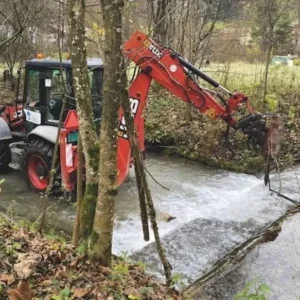The Canadian island of Newfoundland has problems typical of isolated electricity systems. On one hand, demand is growing slowly, and it is not always easy to add a few megawatts here and there to the system. On the other hand, it is possible that new energy-intensive industries may establish themselves on the island; but adding a single large generator can unbalance a system that currently totals only around 2000MW.
Of Newfoundland’s electricity supply, more than 80% is produced by Newfoundland and Labrador Hydro, a crown corporation, and the island has been experiencing ‘modest’ demand growth for some years. The question of providing more capacity arose back in the early 1990s and at that time the options were limited. All of the large scale hydro sites had been developed. A large thermal plant was not favoured, partly because it would unbalance the grid and partly because there are no developed sources of natural gas locally. There were, however, a large number of potential sites for small scale hydro power development.
In 1992 proposals were invited for just such schemes, rated up to 15MW (a size restriction which was later removed). Four projects — totalling 38MW — were chosen, on an electricity price basis, for development. What the utility had not expected, however, was the opposition that the plans would encounter, most noticeably from users of salmon rivers and from nearby protected areas.
In the environmental assessment process two sites — Northwest River (12MW) and Southwest River (7MW) — were withdrawn entirely. The two remaining, Star Lake (15MW) and Rattle Brook (4MW), in fact developed by part of the crown corporation, passed the assessment and construction began with a view to bringing the units into service by the end of 1998. In the event, the plants were never brought into service, and a moratorium on new small hydro was declared; the government of Newfoundland and Labrador asserting that it hoped, ‘that it would be possible to meet the future energy requirements of the island without developments on small ecologically sensitive rivers and watersheds’.
Moratorium and review
The moratorium was declared on 31 August 1998, when the provincial government announced that the province’s entire electricity generation and distribution industry would be considered in a wide-ranging policy review.
Opposition to the small hydro programme was not the only reason for the review. The Newfoundland and Labrador energy industry has grown, not been planned, and its origins a century or more ago can still be seen in its current structure. The crown corporation, Newfoundland and Labrador Hydro, operates most of the generation and transmission services along with distribution and retail in some areas. In the western districts a single investor-owned distribution and retail company has grown by amalgamation of municipal areas; this company also operates some generating facilities. Now this slow change is being affected by developments elsewhere, and the provincial government has decided to complete a thorough review of the entire province’s energy policy.
There are a number of developments driving the review. The fierce opposition to small hydro development certainly gave the planners pause; at the same time, negotiations began on a project that would see up to 4000MW added to the Newfoundland and Labrador system from a large hydro scheme in Labrador, as part of which an 800MW undersea link between Newfoundland and the mainland was mooted (see IWP&DC, January 1999, p33). And in the background lay the revolution in the electricity supply industry of the US, in which competition and privatisation was due to take the place of the monopoly supply companies, offering, depending on your point of view, either a market or a model for Canadian hydro development. The Newfoundland and Labrador government cleared the way for the review by cancelling Star Lake and Rattle Brook, giving compensation for development costs.
According to David Bazeley, director of energy policy at the Ministry of Mines and Energy, the review will be carried out within the Ministry but will use consulting experience. It will include the structure of the industry, regulation, pricing, and future supply, and will assess existing legislation. Bazeley hopes to have the first stage of the report ready by mid-year. Whatever restructuring follows the report, one item firmly off the agenda is privatisation. A proposal was tabled some three years ago to sell off the province’s system, but it was firmly declined by the public. In announcing the review, Premier Brian Tobin emphasised this point when he first announced the review back in August: ‘This review will not raise the issue of hydro privatisation.’ He said, ‘The industry structure review will examine whether or not generation and transmission should be held by one corporate entity, but will not contemplate ownership of Newfoundland and Labrador Hydro by anyone other than the people of the province.’ In six months time developments in the interconnector proposal may make planning for Newfoundland a simpler task. However, it should not be forgotten that power system planning does not always take place in a situation of slow but steady growth. In Newfoundland, for example, a mineral development off shore may bring new industry to the island in the form of nickel processing. No mining lease has yet been signed, but if it goes ahead it will require some 200MW of power — a 10% increase in the island’s capacity.
Related Articles
Spotlight on… Canada






